Analysis of Spatio-Temporal Tsunami Source Models for Reproducing Tsunami Inundation Features
Abstract
:1. Introduction
2. Data
2.1. Bathymetry
2.2. Tsunami Waveform Data
2.3. Field Survey Data
2.4. Tsunami Source Models
3. Method
3.1. Tsunami Numerical Simulation
3.2. Validation of Source Models
4. Results and Discussion
4.1. Tsunami Propagation
4.2. Synthetic Tsunami Waveforms
4.3. Inundation Depths
5. Conclusions
Acknowledgments
Author Contributions
Conflicts of Interest
References
- Fujii, Y.; Satake, K.; Sakai, S.; Shinohara, M.; Kanazawa, T. Tsunami source of the 2011 off the Pacific coast of Tohoku Earthquake. Earth Planets Space 2011, 63, 815–820. [Google Scholar] [CrossRef]
- Gusman, A.R.; Tanioka, Y.; Sakai, S.; Tsushima, H. Source model of the great 2011 Tohoku earthquake estimated from tsunami waveforms and crustal deformation data. Earth Planet. Sci. Lett. 2012, 341–344, 234–242. [Google Scholar] [CrossRef]
- Ammon, C.J.; Lay, T.; Kanamori, H.; Cleveland, M. A rupture model of the 2011 off the Pacific coast of Tohoku Earthquake. Earth Planets Space 2011, 63, 693–696. [Google Scholar] [CrossRef]
- Lay, T.; Ammon, C.J.; Kanamori, H.; Kim, M.J.; Xue, L. Outer trench-slope faulting and the 2011 M w 9.0 off the Pacific coast of Tohoku Earthquake. Earth Planets Space 2011, 63, 713–718. [Google Scholar] [CrossRef]
- Satake, K.; Fujii, Y. Review: Source Models of the 2011 Tohoku Earthquake and Long-Term Forecast of Large Earthquakes. J. Disaster Res. 2014, 9, 272–280. [Google Scholar] [CrossRef]
- MacInnes, B.T.; Gusman, A.R.; LeVeque, R.J.; Tanioka, Y. Comparison of earthquake source models for the 2011 Tohoku event using tsunami simulations and near-field observations. Bull. Seismol. Soc. Am. 2013, 103, 1256–1274. [Google Scholar] [CrossRef]
- Ulutas, E. Comparison of the seafloor displacement from uniform and non-uniform slip models on tsunami simulation of the 2011 Tohoku–Oki earthquake. J. Asian Earth Sci. 2013, 62, 568–585. [Google Scholar] [CrossRef]
- Satake, K.; Fujii, Y.; Harada, T.; Namegaya, Y. Time and Space Distribution of Coseismic Slip of the 2011 Tohoku Earthquake as Inferred from Tsunami Waveform Data. Bull. Seismol. Soc. Am. 2013, 103, 1473–1492. [Google Scholar] [CrossRef]
- Massive Earthquake Model Review Meeting of the Nankai Trough; Cabinet Office, Government of Japan: Tokyo, Japan, 2012.
- Gokon, H.; Koshimura, S. Mapping of Building Damage of the 2011 Tohoku Earthquake Tsunami in Miyagi Prefecture. Coast. Eng. J. 2012, 54, 1250006. [Google Scholar] [CrossRef]
- Suppasri, A.; Mas, E.; Charvet, I.; Gunasekera, R.; Imai, K.; Fukutani, Y.; Abe, Y.; Imamura, F. Building damage characteristics based on surveyed data and fragility curves of the 2011 Great East Japan tsunami. Nat. Hazards 2012, 66, 319–341. [Google Scholar] [CrossRef]
- Mikami, T.; Shibayama, T.; Esteban, M.; Matsumaru, R. Field Survey of the 2011 Tohoku Earthquake and Tsunami in Miyagi and Fukushima Prefectures. Coast. Eng. J. 2012, 54, 1250011. [Google Scholar] [CrossRef]
- Latcharote, P.; Suppasri, A.; Yamashita, A.; Adriano, B.; Koshimura, S.; Kai, Y.; Imamura, F. Mechanism and Stability Analysis of Overturned Buildings by the 2011 Great East Japan Earthquake and Tsunami in Onagawa Town. In Proceedings of the 14th Japan Earthquake Engineering Symposium, Chiba, Japan, 4–6 December 2014; pp. 108–117. [Google Scholar]
- Mori, N.; Takahashi, T.; Yasuda, T.; Yanagisawa, H. Survey of 2011 Tohoku earthquake tsunami inundation and run-up. Geophys. Res. Lett. 2011, 38. [Google Scholar] [CrossRef]
- Mori, N.; Takahashi, T.; The 2011 Tohoku Earthquake Tsunami Joint Survey Group. Nationwide post event survey and analysis of the 2011 Tohoku Earthquake Tsunami. Coast. Eng. J. 2012, 54, 1250001. [Google Scholar] [CrossRef]
- Mori, N.; Cox, D.T.; Yasuda, T.; Mase, H. Overview of the 2011 Tohoku Earthquake Tsunami Damage and Its Relation to Coastal Protection along the Sanriku Coast. Earthq. Spectra 2013, 29, S127–S143. [Google Scholar] [CrossRef]
- Koshimura, S.; Hayashi, S.; Gokon, H. Lessons from the 2011 Tohoku Earthquake Tsunami Disaster. J. Disaster Res. 2013, 8, 549–560. [Google Scholar] [CrossRef]
- Adriano, B.; Hayashi, S.; Gokon, H.; Mas, E.; Koshimura, S. Understanding the Extreme Tsunami Inundation in Onagawa Town by the 2011 Tohoku Earthquake, Its Effects in Urban Structures and Coastal Facilities. Coast. Eng. J. 2016, 58, 1640013. [Google Scholar] [CrossRef]
- Hayashi, S.; Koshimura, S. The 2011 Tohoku Tsunami Flow Velocity Estimation by the Aerial Video Analysis and Numerical Modeling. J. Disaster Res. 2013, 8, 561–572. [Google Scholar] [CrossRef]
- Imamura, F. Review of the tsunami simulation with a finite difference method. In Long Wave Run-up Models; Yeh, H., Liu, P., Synolakis, C., Eds.; World Scientific: Singapore, 1996; pp. 25–42. [Google Scholar]
- Imai, K.; Imamura, F.; Iwama, S. Advanced Tsunami Computation for Urban Regions. J. Jpn. Soc. Civ. Eng. 2013, 69, 311–315. [Google Scholar] [CrossRef]
- Okada, Y. Surface deformation due to shear and tensile faults in a half-space. Bull. Seismol. Soc. Am. 1985, 75, 1135–1154. [Google Scholar]
- Tanioka, Y.; Satake, K. Tsunami generation by horizontal displacement of ocean bottom. Geophys. Res. Lett. 1996, 23, 861. [Google Scholar] [CrossRef]
- Heidarzadeh, M.; Murotani, S.; Satake, K.; Ishibe, T.; Gusman, A.R. Source model of the 16 September 2015 Illapel, Chile, M w 8.4 earthquake based on teleseismic and tsunami data. Geophys. Res. Lett. 2016, 43, 643–650. [Google Scholar] [CrossRef]
- Suppasri, A.; Koshimura, S.; Imai, K.; Mas, E.; Gokon, H.; Muhari, A.; Imamura, F. Damage Characteristic and Field Survey of the 2011 Great East Japan Tsunami in Miyagi Prefecture. Coast. Eng. J. 2012, 54, 1250005. [Google Scholar] [CrossRef]
- Aida, I. Reliability of a tsunami source model derived from fault parameters. J. Phys. Earth 1978, 26, 57–73. [Google Scholar] [CrossRef]
- Tsunami Assessment Method for Nuclear Power Plants in Japan, Japan Society of Civil Engineers. Available online: https://www.jsce.or.jp/committee/ceofnp/Tsunami/eng/JSCE_Tsunami_060519.pdf (accessed on 22 December 2017).
- Satake, K. Linear and nonlinear computations of the 1992 Nicaragua earthquake tsunami. Pure Appl. Geophys. PAGEOPH 1995, 144, 455–470. [Google Scholar] [CrossRef]
- Satake, K.; Tanioka, Y. The July 1998 Papua New Guinea Earthquake: Mechanism and Quantification of Unusual Tsunami Generation. Pure Appl. Geophys. 2003, 160, 2087–2118. [Google Scholar] [CrossRef]
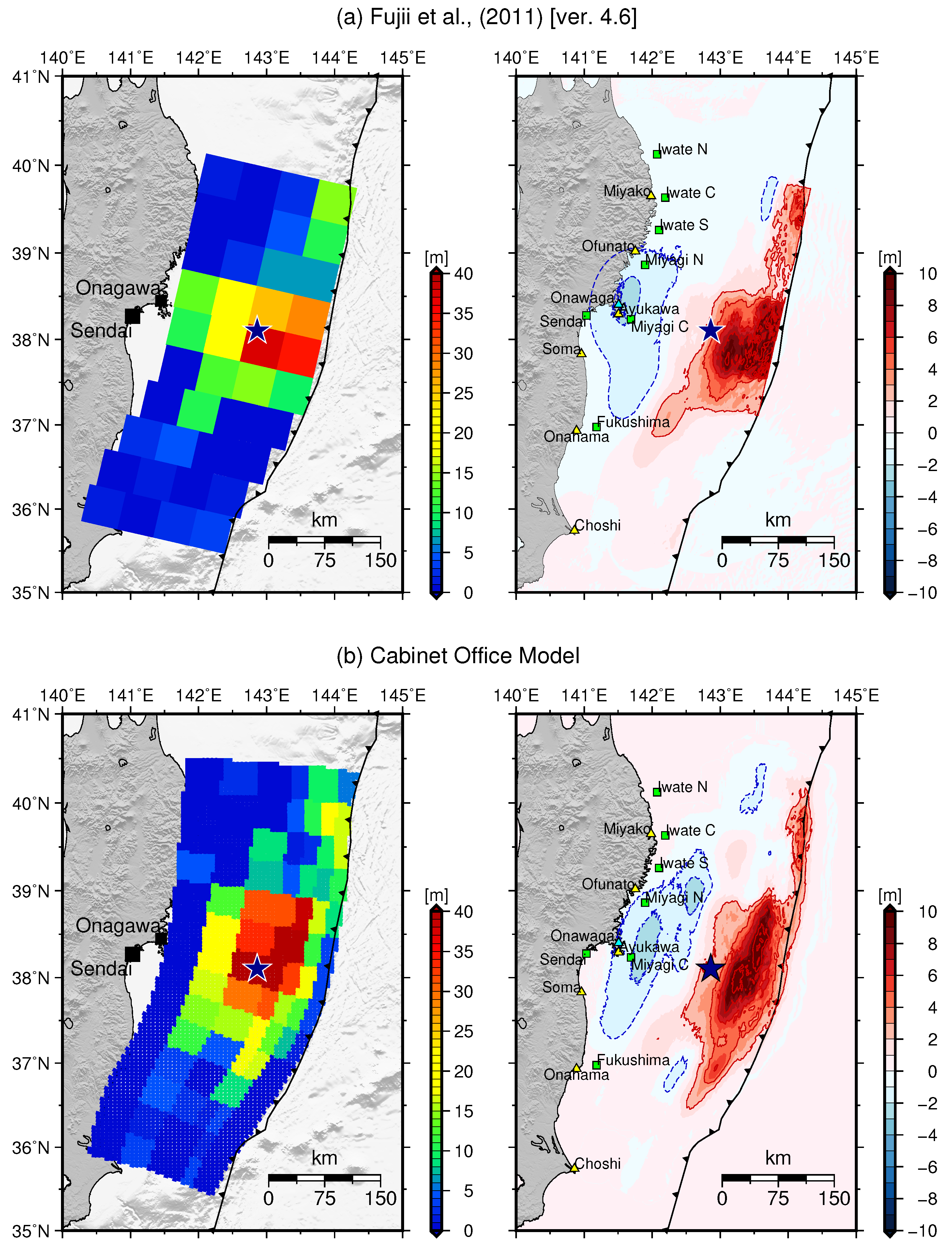

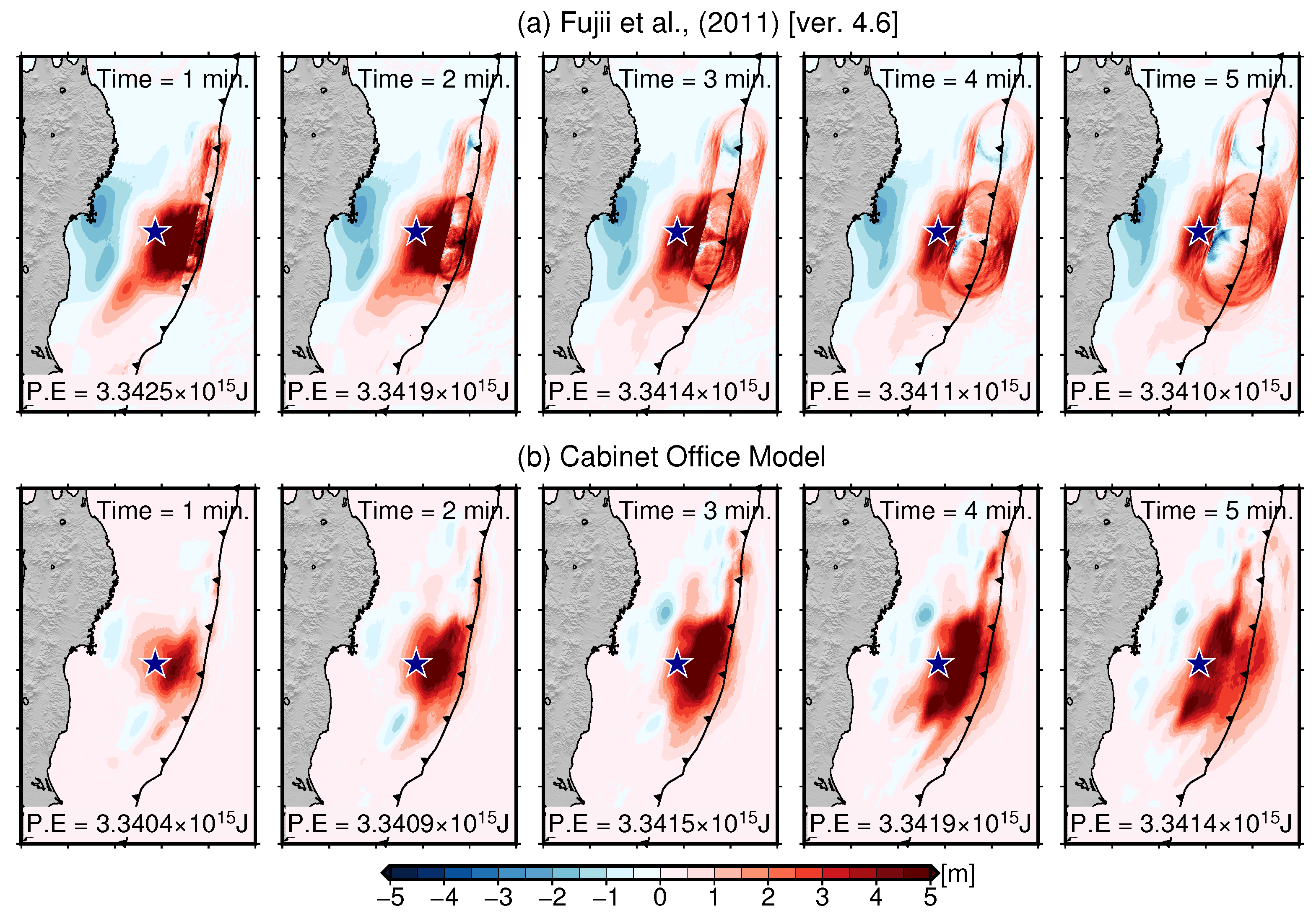

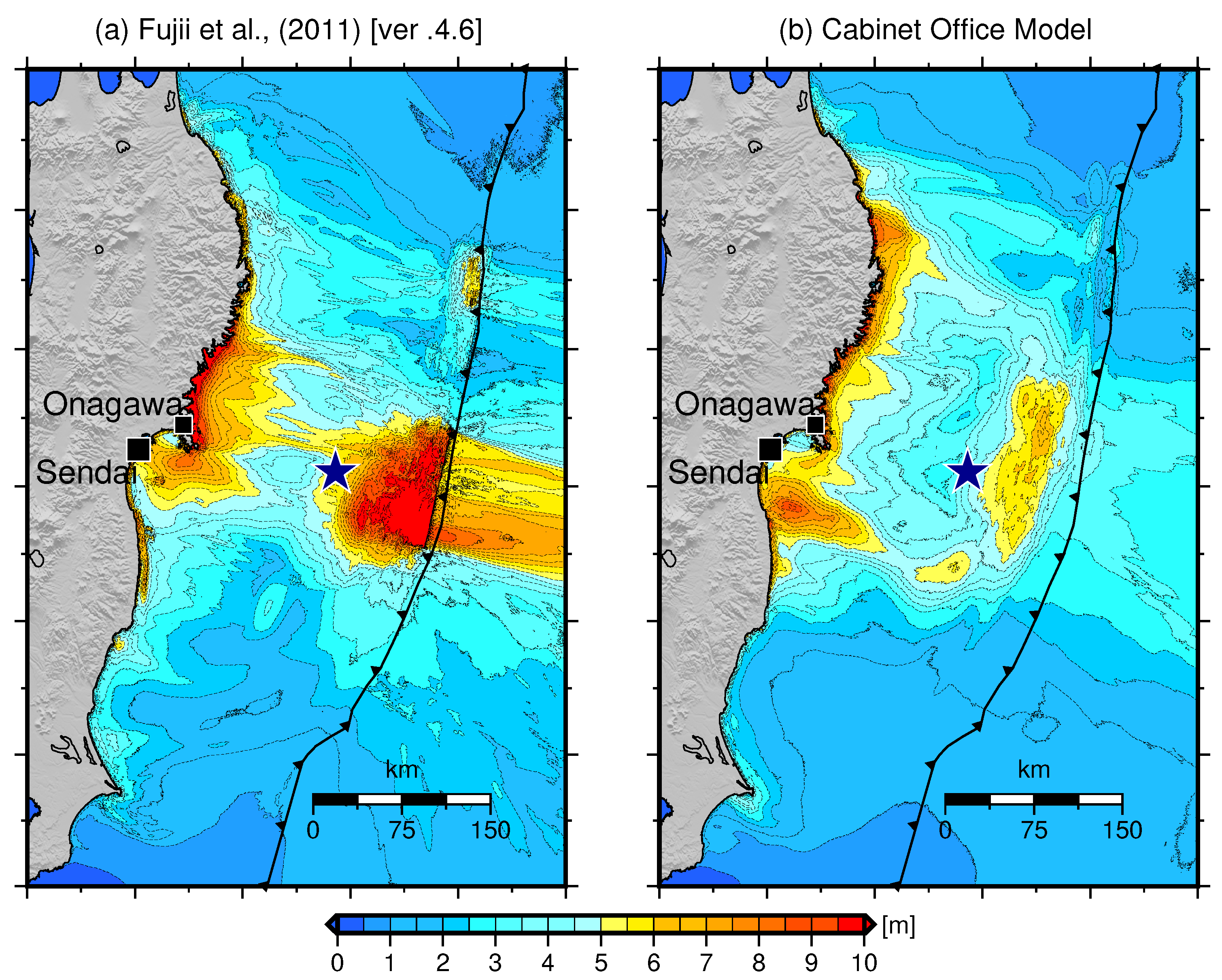

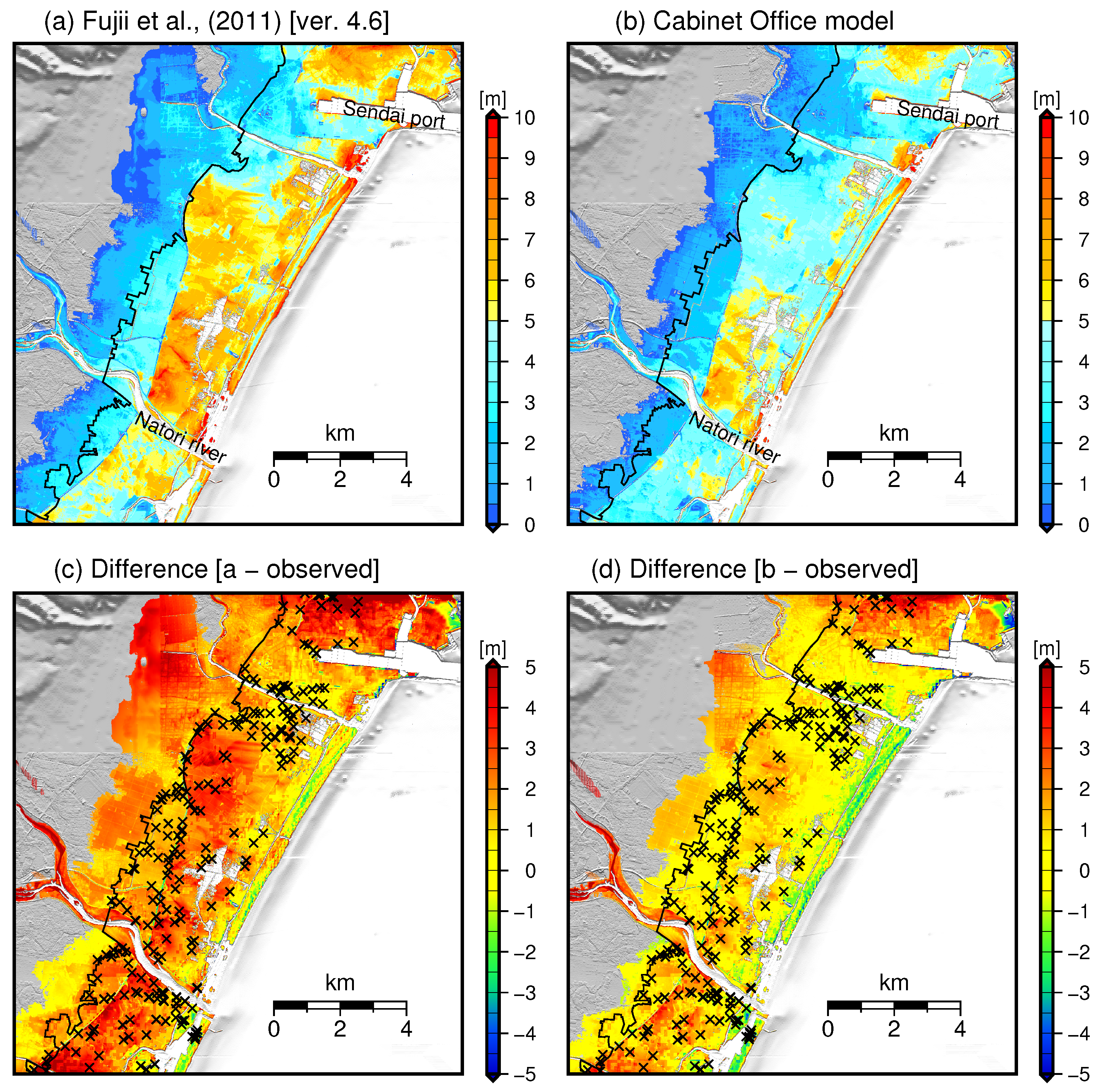
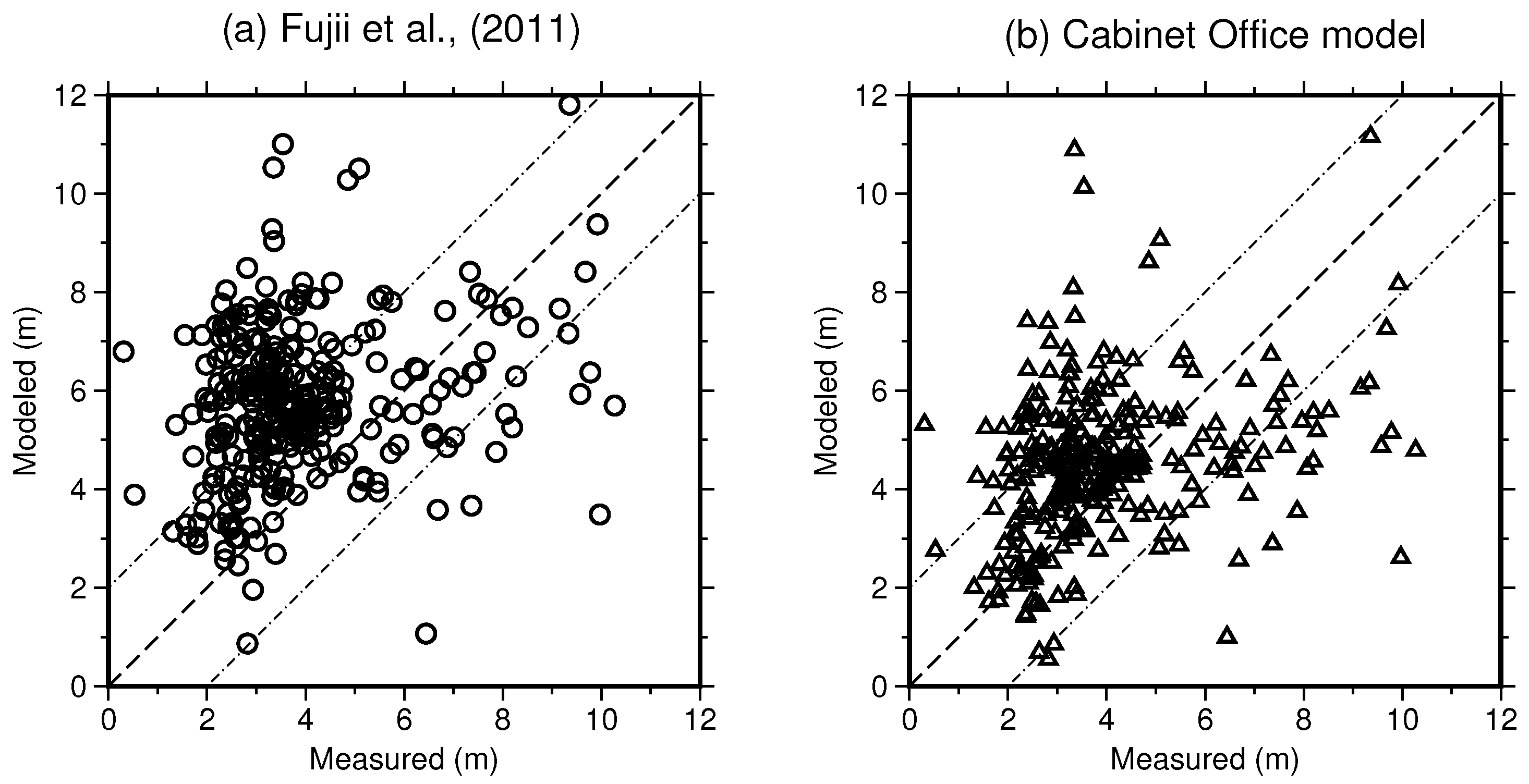
| Model | Onagawa | Sendai | ||
|---|---|---|---|---|
| K | K | |||
| Fujii et al. [1] | 0.45 | 1.11 | 0.58 | 1.11 |
| Cabinet Office model | 0.90 | 1.15 | 0.77 | 1.12 |
© 2017 by the authors. Licensee MDPI, Basel, Switzerland. This article is an open access article distributed under the terms and conditions of the Creative Commons Attribution (CC BY) license (http://creativecommons.org/licenses/by/4.0/).
Share and Cite
Adriano, B.; Hayashi, S.; Koshimura, S. Analysis of Spatio-Temporal Tsunami Source Models for Reproducing Tsunami Inundation Features. Geosciences 2018, 8, 3. https://doi.org/10.3390/geosciences8010003
Adriano B, Hayashi S, Koshimura S. Analysis of Spatio-Temporal Tsunami Source Models for Reproducing Tsunami Inundation Features. Geosciences. 2018; 8(1):3. https://doi.org/10.3390/geosciences8010003
Chicago/Turabian StyleAdriano, Bruno, Satomi Hayashi, and Shunichi Koshimura. 2018. "Analysis of Spatio-Temporal Tsunami Source Models for Reproducing Tsunami Inundation Features" Geosciences 8, no. 1: 3. https://doi.org/10.3390/geosciences8010003







